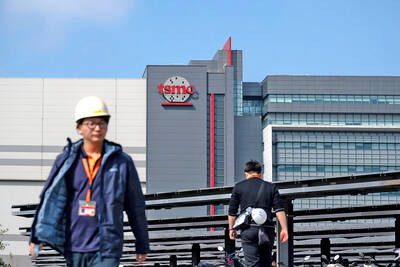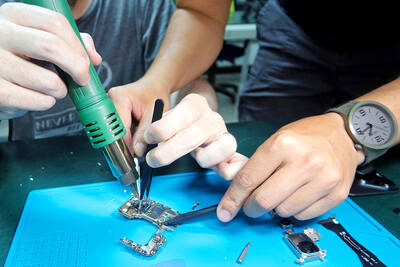Topco Scientific Co (崇越科技) last week reported strong financial results for the first quarter, despite short-term effects on the semiconductor sector from the lingering trade spat between the US and China and the impact of adjustments in supply chain inventories.
While the escalating trade dispute might lead to lower order visibility in the short term, favorable industry trends are still expected to support the company’s business in the mid-to-long term, analysts said.
In addition, China’s policy of building a domestic semiconductor supply chain remains unchanged, which should benefit the company’s business, the analysts added.
Topco Scientific distributes semiconductor materials, mostly photoresists and silicon wafers from Shin-Etsu Chemical Co and slurry from Fujimi Inc.
Its photoresist business has maintained an annual growth rate of up to 5 percent over the past few years, with 70 percent order allocation in Taiwan Semiconductor Manufacturing Co’s (台積電) advanced processes.
Semiconductor-related business account for nearly 80 percent of its total revenue, but Topco Scientific has also seen stable revenue contributions from the factory and environmental engineering businesses over the period.
The booming engineering sector in Taiwan and China in the first quarter helped lift the company’s gross margin to 12.4 percent from 12.21 percent in the same period last year.
SinoPac Securities Investment Service Corp (永豐投顧) maintained its “buy” rating on Topco Scientific shares, which have advanced 20.55 percent so far this year and closed at NT$83.9 on Friday in Taipei trading.
“In light of Chinese wafer fabs’ new capacity ramp-up, the persistent US-China trade dispute seems to have no negative impact on the company’s engineering business, while it is to benefit from rising demand for semiconductor materials in Southeast Asia as more electronics firms relocate their operations from China,” SinoPac analyst Stanley Wang (王彥鈞) said in a client note on Friday.
As demand for silicon wafers and photoresists is to remain strong this quarter, due to higher factory utilization among wafer foundries and the expected contribution from major engineering projects in China, the company’s revenue is forecast to increase 5.7 percent to NT$7.5 billion (US$239.6 million) from NT$7.1 billion last quarter, Wang said.
Gross margin might fall to 12 percent as the company’s higher reliance on wafer foundries gives it less bargaining power in pricing, with net profit dropping 7.6 percent quarter-on-quarter to NT$360 million, or earnings per share of NT$1.97, he said.
The company reported that net profit rose 45.59 percent annually to NT$386.57 million in the first quarter — the highest first-quarter figure in its history — with earnings per share of NT$2.13, an earnings presentation document showed on Thursday.
Operating profit increased at a slower pace of 19.87 percent to NT$398.82 million, partly due to research and development expenses, it said.
Losses from AnyongFresh (安永生鮮), the company’s investment in the healthy food and distribution segment, contracted to NT$40 million in the first quarter.
The company said it aims to contain the losses to within NT$200 million this year.

Apple Inc has closed in on an agreement with OpenAI to use the start-up’s technology on the iPhone, part of a broader push to bring artificial intelligence (AI) features to its devices, people familiar with the matter said. The two sides have been finalizing terms for a pact to use ChatGPT features in Apple’s iOS 18, the next iPhone operating system, said the people, who asked not to be identified because the situation is private. Apple also has held talks with Alphabet Inc’s Google about licensing its Gemini chatbot. Those discussions have not led to an agreement, but are ongoing. An OpenAI

INSATIABLE: Almost all AI innovators are working with the chipmaker to address the rapidly growing AI-related demand for energy-efficient computing power, the CEO said Taiwan Semiconductor Manufacturing Co (TSMC, 台積電) yesterday reported about 60 percent annual growth in revenue for last month, benefiting from rapidly growing demand for artificial intelligence (AI) and high-performance computing applications. Revenue last month expanded to NT$236.02 billion (US$7.28 billion), compared with NT$147.9 billion in April last year, the second-highest level in company history, TSMC said in a statement. On a monthly basis, revenue surged 20.9 percent, from NT$195.21 billion in March. As AI-related applications continue to show strong growth, TSMC expects revenue to expand about 27.6 percent year-on-year during the current quarter to between US$19.6 billion and US$20.4 billion. That would

‘FULL SUPPORT’: Kumamoto Governor Takashi Kimura said he hopes more companies would settle in the prefecture to create an area similar to Taiwan’s Hsinchu Science Park The newly elected governor of Japan’s Kumamoto Prefecture said he is ready to ensure wide-ranging support to woo Taiwan Semiconductor Manufacturing Co (TSMC, 台積電) to build its third Japanese chip factory there. Concerns of groundwater shortages when TSMC’s two plants begin operations in the prefecture’s Kikuyo have spurred discussions about the possibility of tapping unused dam water, Kumamoto Governor Takashi Kimura said in an interview on Saturday. While Kimura said talks about a third plant have yet to occur, Bloomberg had reported TSMC is already considering its third Japanese fab — also in Kumamoto — which would make more advanced chips. “We are

Huawei Technologies Co’s (華為) latest high-end smartphone features more Chinese suppliers, including a new flash memory chip and an improved chip processor, a teardown analysis showed, pointing to the progress China is making toward technology self-sufficiency. The inside of Huawei’s Pura 70 Pro was examined by online tech repair company iFixit and consultancy TechSearch International, finding components made by Chinese suppliers. The firms also found that the Pura 70 phones run on an advanced processing chipset made by Chinese chip foundry Semiconductor Manufacturing International Corp (SMIC, 中芯) called the Kirin 9010, which is likely a slightly improved version of the advanced chip